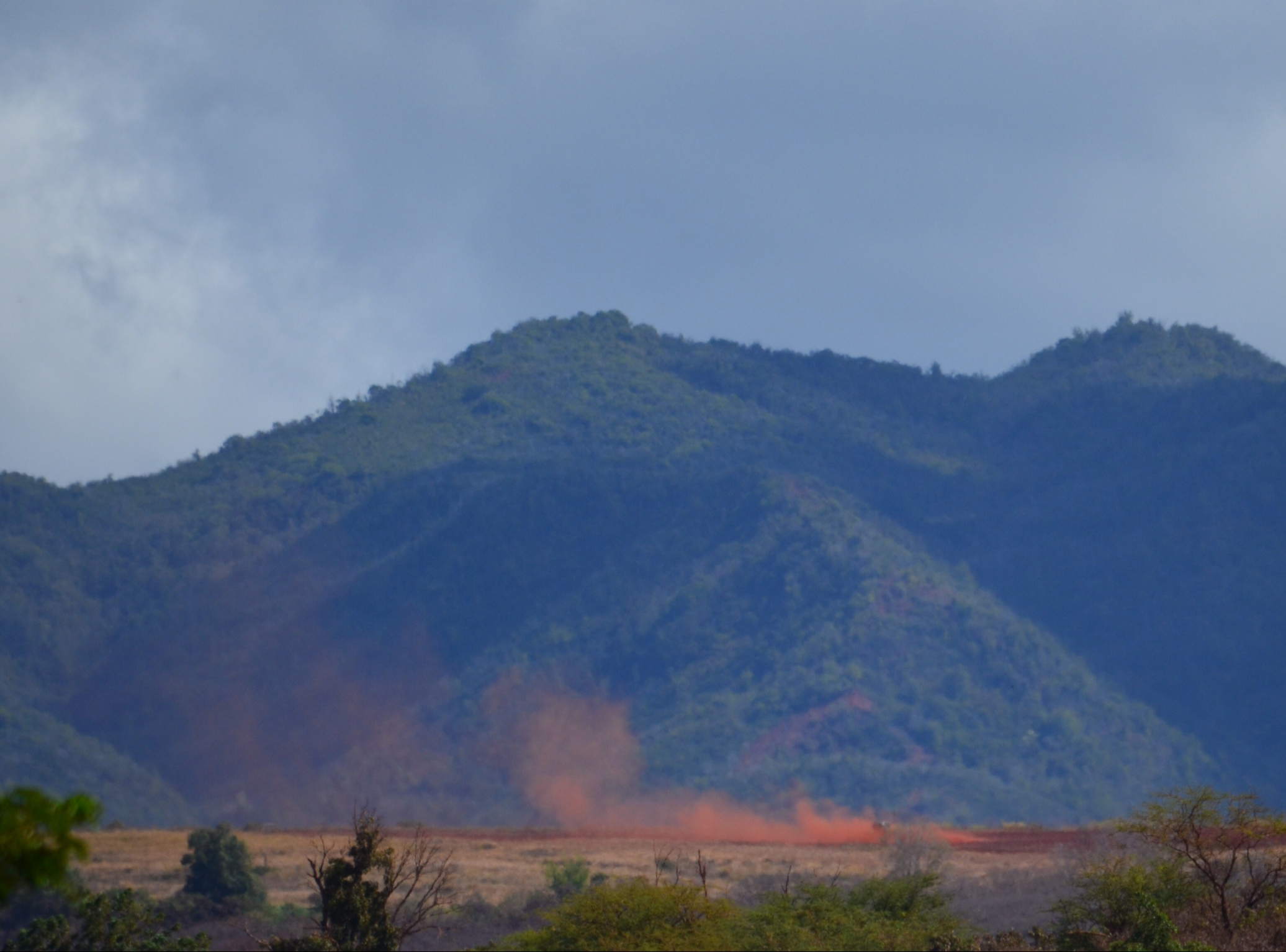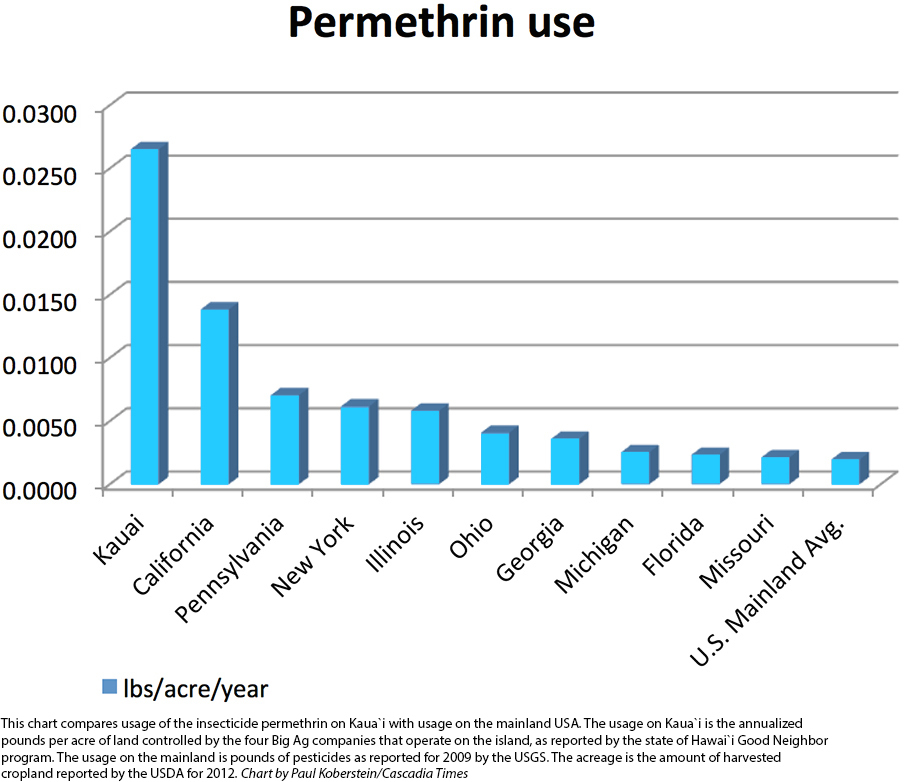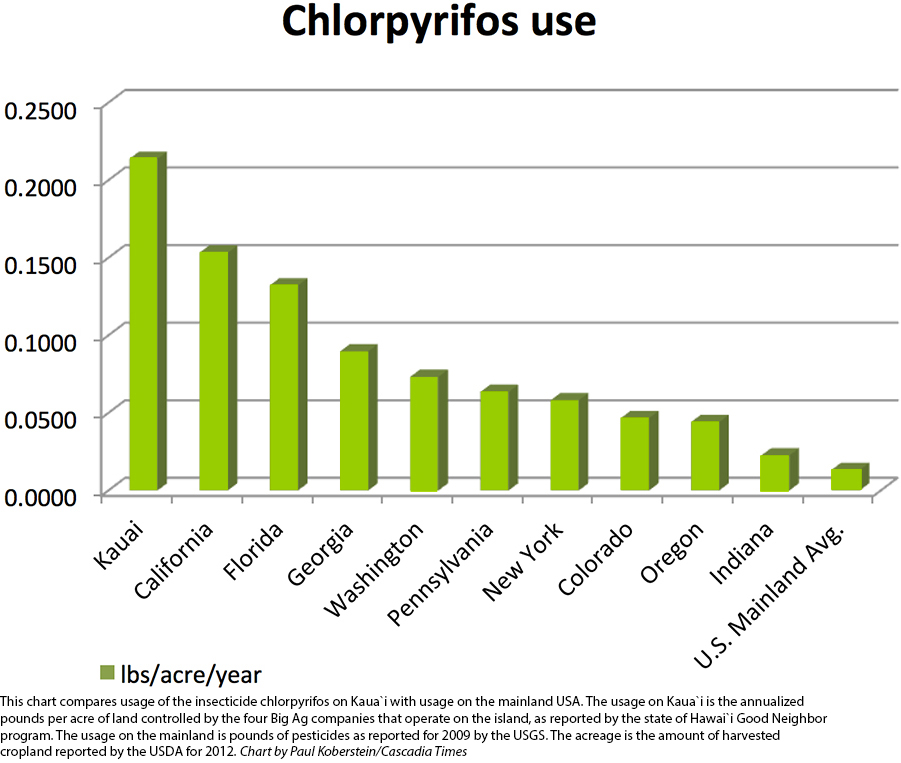Submitted by PR Watch Admin on
-- by Paul Koberstein, Cascadia Times
 WAIMEA, HAWAI'I – The island of Kaua'i, Hawai'i, has become Ground Zero in the intense political battle over genetically modified (GMO) crops in the United States. But the fight isn't just about the concerns over GMO technology. It's also about chemical pesticides.
WAIMEA, HAWAI'I – The island of Kaua'i, Hawai'i, has become Ground Zero in the intense political battle over genetically modified (GMO) crops in the United States. But the fight isn't just about the concerns over GMO technology. It's also about chemical pesticides.
The four transnational corporations that are experimenting with genetically engineered crops on Kaua'i have transformed part of the island into what could be one of the most toxic chemical environments in all of U.S. agriculture.
For the better part of two decades, Syngenta, BASF Plant Science, DuPont Pioneer and Dow AgroSciences have been drenching their test crops near this small town on the southwest coast of Kaua'i with some of the most dangerous synthetic pesticides in use in agriculture today, at an intensity that far surpasses the norm at most other American farms, an analysis of government pesticide databases shows.
Residents of "Poison Valley"
Perhaps no one personifies the battle better than Klayton Kubo, who lives at the east end of Waimea, at the heart of what he calls "poison valley." He showed this reporter a brief video of himself cleaning the screen covering the window on the street side of his house. Clogged with reddish dirt similar in appearance to volcanic soils found throughout the island, the screen is his house’s last line of defense against the dust. However, it blocks only the biggest chunks, and can do nothing to stop smaller pieces of grit, toxic vapors and chemical odors that appear to be emanating from test fields located just beyond the street and the Waimea River in front of his house.
Kubo began looking for answers to his questions about what’s in the air some 15 years ago. More than once, he says, a DuPont representative came to his house only to lower his head and mutter that it’s "against company policy" to reveal any information about activities on the test fields.
Kubo is among 150 of his neighbors who have joined a class action lawsuit against DuPont Pioneer, a subsidiary of DuPont that leases several thousand acres on Kaua'i. They are seeking an injunction against the use of chemicals that are suspected to be toxic. At the other end of town, the Waimea Canyon Middle School, a health clinic, and a veterans' hospital line up in front of another GMO test field operated by Syngenta.
Steady northeasterly trade winds averaging between 8 and 9 mph blow daily across the test fields and into town.
In two incidents in 2006 and 2008, students at the Waimea school were evacuated and about 60 were hospitalized with flu-like symptoms such as dizziness, headaches, and nausea. Many people in town blamed the outbreak on blowing dust from the GMO test fields. The companies blamed nearby fields of stinkweed.
To find out what actually happened, federal, state and local government agencies in 2010 collaborated to test the air at the school for the presence of 24 kinds of toxic pesticides used on the test fields as well as for chemicals emitted by stinkweed. The study was inconclusive, finding that the "symptoms could be consistent with exposure to certain pesticides, but could also be caused by exposure to volatile chemicals emitted from natural sources, such as stinkweed."
It detected traces of the toxic pesticide chlorpyrifos in the air both inside and outside the school, but said it found "no evidence to indicate that pesticides had been used improperly." Concentrations of all chemicals were below EPA exposure limits at the time of testing, which occurred years after the evacuation.
But Gerard Jervis, a Honolulu lawyer representing the residents in the class-action lawsuit, said he doubted stinkweed was the source of the problem. Chemicals emitted by stinkweed are found in the air at similar concentrations elsewhere on the island and to his knowledge have never caused any health problems, he said. Moreover, the concentrations of airborne pesticides were found at much higher levels in Waimea than elsewhere on the island.
Jervis also noted that the air quality study did not even try to look for more than 30 specific pesticides that have been used at the GMO test fields since 2007, including two of the most dangerous: paraquat, a weed-killer, and methomyl, an insecticide.
Each of the seven most toxic chemicals commonly used on the test fields has been linked to a variety of serious health problems ranging from childhood cognitive disorders to cancer. And when applied together in a toxic cocktail, their joint action can make them even more dangerous to exposed people.
Kaua'i: Ground Zero
Last fall, the Kaua'i County Council enacted Ordinance 960, the first local laws in the United States that specifically regulates the cultivation of existing GMO crops (as opposed to preempting future GMO crops), despite an aggressive pushback from the industry, which contends that existing federal regulations suffice.
The GMO field experiments are supervised by the U.S. Department of Agriculture, and the pesticides have the Environmental Protection Agency's stamp of approval.
But where some see oversight, others see blinders.
Kaua'i County, which encompasses the entire island, contends that the federal agencies have ignored effects on public health while allowing the corporations to freely pursue profits. Therefore, it has claimed authority to regulate the pesticides used within its borders.
Ordinance 960 -- which was designed to prevent such outbreaks from recurring -- creates no-spray buffer zones near schools and other buildings where people live, work, or receive medical care, but is not a complete ban of GMO crops. In recent weeks, however, Kaua'i residents have proposed an amendment to the County Charter that would tighten the new regulations a lot further by adopting the "precautionary principle." If approved in a countywide vote, it would ban all GMO cultivation until the companies can prove to the county’s satisfaction that their pesticide usage does not harm public health.
The agribusiness companies are not going to back down without a fight.
In January, the companies filed suit in an effort to uproot Ordinance 960 in the courts. A ruling on the suit is expected before it takes effect in August.
They are also expected to mount a vigorous political campaign to fight the charter amendment and to support a slate of GMO-friendly candidates to compete with pro-960 candidates in the November general election, when the mayor and all seven County Council seats are on the ballot.
"Kaua'i is Ground Zero for the testing of GMO crops," said Gary Hooser, a member of the Kaua'i County Council and an author of Ordinance 960. "It is also Ground Zero for democracy in action."
Why Kaua'i?
The four agribusiness giants chose to locate their R&D work in the tropical climate of the Hawaiian Islands because it enables them to work their fields year-around, expanding the annual growing calendar to three or four seasons while compressing the time it takes to develop a new genetically altered seed by nearly half.
The companies produce much more than new-fangled seeds.
At their core, they are large chemical companies that manufacture many types of agricultural chemicals. A major chunk of their income is generated from the sale of chemicals to farmers on the U.S. mainland. The farmers are told that they must use the chemicals in order to protect their pricey GMO crops from never-ending attacks by bugs and weeds. The agribusinesses are like printer manufacturers that make more money selling high-priced ink cartridges than the printers themselves.
Consider Monsanto's development of "Roundup Ready" corn and soybean seeds. They can resist applications of the herbicide glyphosate, sold most commonly as Roundup. Ideally, on Roundup Ready fields, the crops live while the weeds die.
However, in the 18 years that Roundup Ready seeds have been on the market, they have lost much of their effectiveness. The crops still survive, but on many farms across the U.S., a significant percentage of the weeds have mutated to the point that they no longer die as intended. Increasingly, varieties of herbicide-resistant superweeds are sprouting up in fields worldwide, wherever Roundup Ready crops are grown. On some fields, insecticide-resistant superbugs such as the corn rootworm are creating an additional set of problems for GMO farmers.
The companies have responded by trying to create new seed varieties that can coexist with other chemicals that they hope can be used to enhance or replace Roundup.
For example, Dow has developed new corn and soybean seeds that are resistant to the herbicide 2,4-D, an older herbicide that kills broadleaf plants and was an active ingredient of the Vietnam War-era Agent Orange that's linked to reproductive problems and cancer.
The company has asked the U.S. Department of Agriculture (USDA) to approve the seeds in hopes that a new generation of herbicide-tolerant crops can come to the market. Dow has given no bankable assurance that overuse of 2,4-D won’t create additional new varieties of superweeds.
Hooser said that Dow officials told him that research conducted on Kaua'i played a key role in the development of 2,4-D-resistant seeds.
A National Institutes of Health (NIH) panel opined that 2,4-D is a possible carcinogen but that further investigation is needed, particularly for a possible association with non-Hodgkin's lymphoma.
Steady Trade Winds Blow Poisons Across Kaua'i
 Some of the pesticides in use on the test fields around Waimea are toxic enough to pose a serious health threat to its population of 1,855, even when used according to directions.
Some of the pesticides in use on the test fields around Waimea are toxic enough to pose a serious health threat to its population of 1,855, even when used according to directions.
These are classified as "restricted use pesticides," meaning they are more tightly regulated by the Environmental Protection Agency (EPA) than "general use pesticides."
The restricted-use chemicals used most heavily on the GMO test fields of Kaua'i are atrazine, permethrin, chlorpyrifos, paraquat, methomyl, metolachlor, and alachlor.
A database showing how much of the restricted pesticides were used on Kaua'i from December 2013 through April 2014 was voluntarily released by the four companies and posted to the Hawai'i Department of Agriculture website, as the result of negotiations with Governor Neil Abercrombie. The Cascadia Times compared that information to 2009 data from a U.S. Geological Survey database on pesticide usage in the United States.
The Cascadia Times found that annualized pounds-per-acre usage of the seven most toxic pesticides on Kaua'i was greater, on average, than in all but four states: Florida, Louisiana, North Carolina and Indiana. (For the purpose of this comparison, the analysis assumed the chemical companies used pesticides on all 12,000 acres they control on the island. It also assumed that farmers used pesticides on all 314 million acres of harvested cropland on the mainland U.S. Organic farms that don't use synthetic pesticides encompass slightly more than one percent of U.S. agricultural land, according to the USDA’s National Agricultural Statistics Service.
 As shown by these charts, the per-acre usage of the bug-killers known as chlorpyrifos and permethrin on Kaua'i is each projected to be significantly greater on average than in California and more than 10 times greater than the national average.
As shown by these charts, the per-acre usage of the bug-killers known as chlorpyrifos and permethrin on Kaua'i is each projected to be significantly greater on average than in California and more than 10 times greater than the national average.
This analysis also projects that Kaua'i would rank second nationally for methomyl, fifth for metolachlor, sixth for alachlor, ninth for paraquat, and 23rd for atrazine, which is the second most heavily used herbicide in the U.S. and is applied to more than half the corn in the country.
Dr. Steve Savage has also found that the overall pounds-per-acre pesticide usage on Kaua'i is among the highest in the nation. However, he said that 98 percent of the pesticides used on the island are general-use ones that are less toxic than a cup of coffee. Savage is a former professor at Colorado State University and former employee of DuPont.
Even if that generous ballpark figure were accurate, the remaining two percent would give serious cause for concern, Savage said.
"Different pesticides can vary in something like their toxicity to mammals by more than 1000-fold," he said.
Six of the seven restricted-use pesticides used most heavily on Kaua'i are suspected of being endocrine disruptors, according to the EPA. Endocrine disruptors can cause reproductive problems and may result in an increased incidence in some problems in humans and animals, according to the NIH.
Tyrone Hayes, an endocrinologist at the University of California-Berkeley whose reputation has been viciously attacked by Syngenta, has raised particular concerns about the potentially gender-bending effects of even tiny amounts of atrazine.
A review of the scientific literature published in March in the British journal The Lancet Neurology also found that chlorpyrifos, a neurotoxin, is one of a dozen chemicals commonly found in the environment that "injure the developing brain" of children.
Four of the seven heavily used restricted pesticides are suspected or likely carcinogens. And between them, the seven have been linked to, among other things, neurological and brain problems and damage to the lungs, heart, kidneys, adrenal glands, central nervous system, muscles, spleen, and liver.
Combine them together and the effects could be even worse, especially in prenatal and early postnatal development.
The EPA knows little about the synergistic effects, or combined power, of multiple chemicals when people are exposed to them at the same time. However, it recently observed that the joint action of atrazine and chlorpyrifos can result in "greater than additive toxicity."
In other words, the whole cocktail can pack a bigger punch than the sum of its ingredients.
In another example, the combined presence of the insecticides permethrin and chlorpyrifos has also been shown to be "even more acutely toxic" than the sum of each, according to former EPA scientist E. G. Vallianatos.
As if all that weren't bad enough, there's reason to believe that the agri-giants might be violating federal rules about the application of the restricted-use pesticides on Kaua'i. The rules are supposed to ensure that the pesticides do their damage to bugs and weeds, not kids.
For example, consider Dow's Lorsban, which consists of about 45 percent chlorpyrifos. Lorsban is the single most heavily-used restricted-use pesticide product on the Kaua'i test fields. The EPA prohibits its application whenever the wind blows greater than 10 mph. The average wind speed in Waimea is between eight and nine MPH, according to the National Weather Service, meaning that on many days the spraying of Lorsban might not be legal. Klayton Kubo, whose Waimea home is within a half-mile of DuPont’s fields, says stiff winds blow across the island "80 percent of the time."
When the school was tested for chemicals after the kids grew ill and had to be evacuated in 2006 and 2008, chlorpyrifos -- Lorsban's active ingredient -- was present years later (records show it is sprayed on a regular basis), at levels "well below health concern exposure limits." However, some fear that its use in the fields may have contributed to the need to evacuate.
The EPA says that applicators must "not allow spray to drift from the application site and contact people, structures people occupy at any time and the associated property, parks and recreation areas, non-target crops, aquatic and wetland sites, woodlands, pastures, rangelands, or animals."
"Avoiding spray drift at the application site," the EPA points out, "is the responsibility of the applicator."
In Waimea's windy climate, it's a rare day when Lorsban and the other heavily-used toxic chemicals can be applied to the test fields without the wind blowing them right into somebody's face.
 This article is part of "What The Fork!?! Corporations and Democracy," a collaborative media effort investigating corporate control of our democracy and our dinner plates. Articles and radio pieces combine work of Making Contact, The Progressive, the Center for Media and Democracy (publisher of ALECexposed.org), and Food Democracy Now, along with reporting from Earth Island Journal, Grist, and Cascadia Times. Made possible in part by the Voqal Fund. Read stories and take action at wtfcorporations.com, and follow #wtfcorps and #BigAg on Twitter and Facebook.
This article is part of "What The Fork!?! Corporations and Democracy," a collaborative media effort investigating corporate control of our democracy and our dinner plates. Articles and radio pieces combine work of Making Contact, The Progressive, the Center for Media and Democracy (publisher of ALECexposed.org), and Food Democracy Now, along with reporting from Earth Island Journal, Grist, and Cascadia Times. Made possible in part by the Voqal Fund. Read stories and take action at wtfcorporations.com, and follow #wtfcorps and #BigAg on Twitter and Facebook.
Paul Koberstein is editor of Cascadia Times, an environmental journal published in Portland, Oregon. He is a former staff writer for Willamette Week and The Oregonian. In 2004, he won the John B. Oakes Award for distinguished environmental journalism for articles on the Northwestern Hawaiian Islands.
The charts in this article were compiled from a computer-assisted analysis of the most recent information from the USGS data set and the full Kaua'i data set by Cascadia Times.
